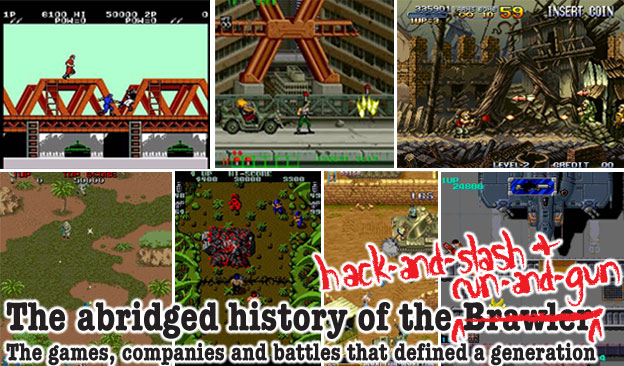
The majority of titles that I had been featuring over the past few weeks were designed and developed in Japan. The few attempts to move the brawler into 3D attempted by Western developers were dismal, see Final Fight: Streetwise for proof. However those studios would continue working in 3D and learning what genres and mechanics could make for great gaming experiences. One of the major breakout titles was with Tomb Raider featuring Lara Croft. Developed by Core Design in 1996 the game married the adventure explorer with the run-and-gun in 3D. The formula and format would be copied by just about every major western publisher over the next decade and a half, earning several sequels on the consoles and computers for Lara herself.
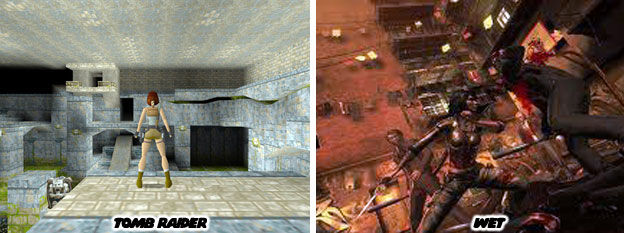
The most recent effort to try and recreate the formula was seen in Bethesda's WET featuring Rubi Malone, and released in 2009. In the game players could run along walls and slide down ladders while inverted and continue shooting at enemies. The 3D shooters through most of the 2000’s were different from those previously. The shooter was becoming a stylistic experience rather than a simulation. The shooter would detach itself from reality like the 3D hack-and-slash experiences did for Dynasty Warriors. The main characters Laura and Rubi were super athletes and could perform acrobatics with guns and seemingly never miss a target.
Capcom was responsible for marrying the hack-and-slash with acrobatic run-and-gun in 2001. Devil May Cry was the benchmark by which all action games would be measured against for the next decade. The main character, Dante, could fight armies single handedly and more important look cool doing it, by extension making gamers feel cool also. The game allowed players to take on hordes of opponents using a large sword with the dizzying combos of a Dynasty Warrior character, they could then further pick them apart with an automatic pistol, literally juggling the corpses in the air.
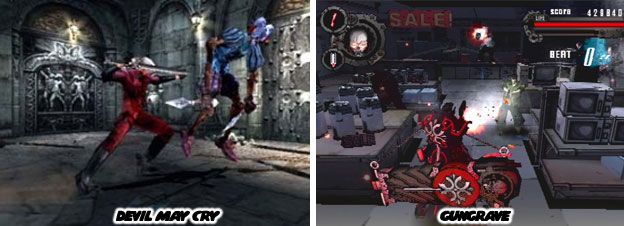
Sega would take the gun crazy combo system to another level. In 2002 they released Gungrave, an overdose of testosterone and one of the games that I would label “combo pornography.” In the Sega game players could shoot everything and anything and be rewarded for keeping up the body count with an endless supply of bullets. Players could even punctuate a string of shootouts with a cool pose via the push of a button. Young male gamers had been drawn to the early brawlers because they got to pound the snot of some gang members.
Gungrave and Devil May Cry took the same violence, machismo and cool factor to unprecedented levels. Players no longer had to join in with the group brawler to feel like a tough guy. In fact games like Tomb Raider, DMC and Gungrave worked better as a single player experience. Nothing could have diminished the characters or the experience more than sharing the spotlight with multiple characters Other studios followed the example that Capcom had established and began reworking the formula. For example; in 2002 Sega’s in house developer Smilebit, more famous for the Jet Set Radio series, developed a fantastic science fiction run-and-gun title called Gun Valkyrie. In it a single character in a powered suit could mow down the population of an alien planet.
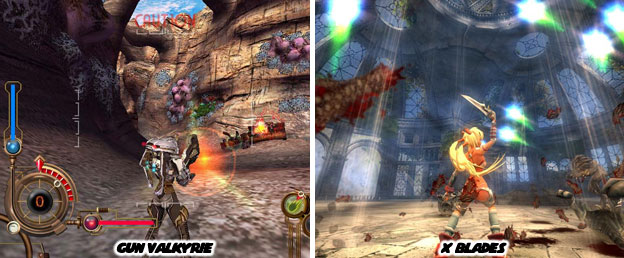
Independent studios even began copying the formula and creating their own interpretation of the genre. Russian studio 1C Company released an anime style adventure called X Blades in 2007. By following the template they were able to create a game that was familiar but could not top the originators at Capcom. It was not unlike the independent studios releasing multi-player brawling games in the arcade during the late 90’s. The style of gameplay had a lot of influence over character design. Since the main characters in these types of games had to be acrobatic and look cool performing the moves it was decided that players would enjoy watching females rather than males as the heroes. Japan took the concept of the sexy shooter to new levels. Cacpom released a sci-fi shooter named P.N. 03 in 2003. The title was short for Project Nude. Directed by Shinji Mikami of God Hand and Viewtiful Joe fame, P.N. 03 featured Vanessa, a heroine dressed in a tight white rubber suit, literally striking poses and dancing her way through the game while shooting at opponents with laser blasts.
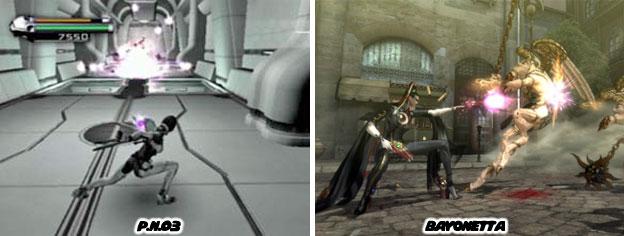
A few years later Capcom released what many would consider to be the spiritual successor to Devil May Cry. Bayonetta, developed by Platinum Games (for whom Shinji Mikami is a board member) in 2009 was a spectacle, featuring more style, absurd combos and sex appeal than any other shooter to date. What I saw and very few writers bothered to mention was that it mirrored P.N 03 in many ways.
The hero, or in this case heroine of the single player brawling experience had established a new set of gameplay elements. Whereas characters in the classic arcade brawlers were marginally better than the opponents they faced, the main characters in console brawlers had to be exponentially more powerful than the majority of characters they faced. Also these characters would have to be able to become more powerful as the game progressed in order to take down even stronger opponents and not feel redundant to gamers. The most important lessons taught by the brawler would be adopted by Western developers in the second half of the decade. While Japan was heaping artistic style onto the genre the US developers were learning the nuances of the hardware and gameplay. After almost 30 years of domination by Japanese developers the day would come when the most original and memorable experiences were being created by the West. The next blog wraps up our look at the abridged history of the brawler. As always if you enjoyed this blog and would like to sponsor me please visit my Patreon page and consider donating each month, even as little as $1 would help make better blogs and even podcasts!

No comments:
Post a Comment